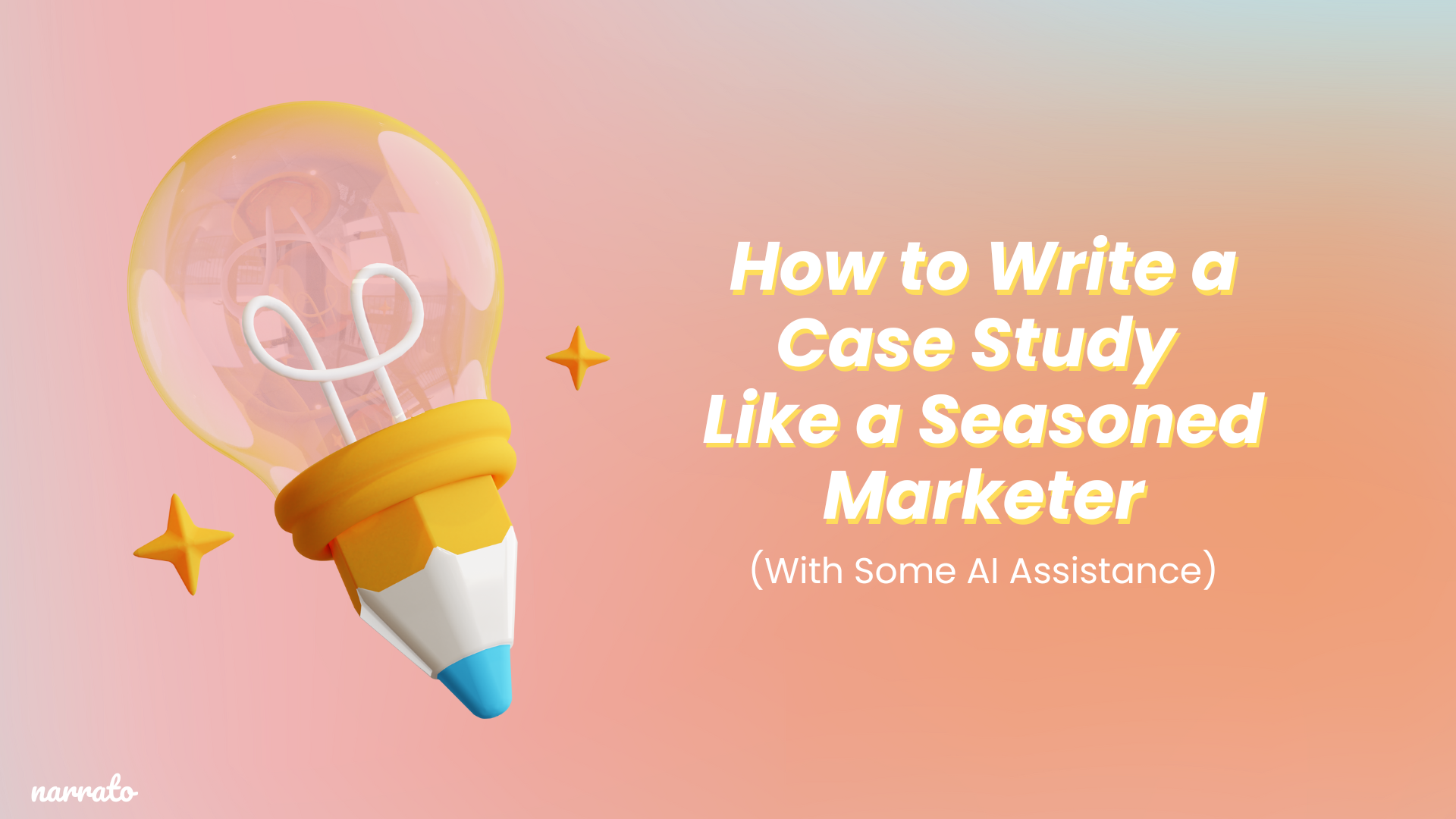Writing a case study and not quite sure where to start or how to finish? You’re not alone. Every marketer knows the struggle of transforming client success into a narrative that converts. But with a structured approach and a little help from AI, you can create a compelling case study in no time. Narrato’s AI case study generator can transform your notes into comprehensive, professional case studies that highlight your product’s strengths, all while cutting down the time and effort traditionally required. This guide will explain how to write a case study using insights and techniques employed by seasoned marketers, while also integrating AI to simplify content creation and overall impact.
What is a case study? How to write one?
Preparation steps for writing your case study
How to write a case study with AI
Tips for writing a compelling case study

What is a case study and how to write one?
Did you know, 89% of consumers look at online reviews when shopping online and 49% count positive reviews among their top three factors influencing their buying decisions. And a case studies are nothing but a more detailed form of reviews. A case study is a detailed success story that showcases how a company’s product or service has helped a customer solve a problem or achieve a goal. It’s basically a blog writing format that provides real-world examples demonstrating the effectiveness and benefits of what the company offers.
Case studies typically include background information on the customer or client, the challenges they were facing, the solutions provided by the company, and the positive outcomes that resulted. By illustrating these real-life examples, case studies help potential customers understand the practical applications of a product or service and visualize how it could benefit them. They’re like little stories that build trust and show prospective clients that, “Hey, this worked for someone just like you!”
To craft a compelling case study, there are a few tried-and-true frameworks that marketers commonly use:
- Problem-Solution Framework: This framework centers on identifying a specific problem, analyzing its root causes, and exploring the implemented solutions. It concludes by evaluating the outcomes of those solutions and extracting learnings or recommendations.
- Narrative Framework: This framework tells the story of the case study, focusing on the sequence of events and key turning points. It often has a dramatic arc, detailing challenges, actions, and resolutions in a narrative format.
- Before-and-After Framework: This approach contrasts the situation before and after an intervention. It focuses on the changes brought about by specific actions, assessing the impact and effectiveness of those interventions.
- The 5 C’s Framework: This involves analyzing five key areas: Company, Customers, Competitors, Collaborators, and Context. It provides a holistic overview of the subject’s internal and external business environment.
Each framework provides a structured method to analyze and present information in your case study, allowing for different angles of understanding depending on the case study’s focus and objectives.
Creating a case study using any of these frameworks can be a time-consuming process, often requiring careful research, analysis, and writing to capture the attention of potential clients. This is where an AI case study generator steps in as a game-changer. It can significantly reduce the time spent on the more labor-intensive aspects of case study creation.
What is an AI case study generator?
An AI case study generator automates the process of creating high-converting case studies. This AI tool makes it faster and easier to write informative, data-based case studies, which help businesses showcase their product’s effectiveness. Unlike traditional case study creation that requires a lot of time and effort, this tool only needs a few inputs from you. Simply provide some context, along with raw data and notes, and the AI will analyze it to create a detailed customer case study
Narrato’s AI Content Assistant offers an AI case study generator that allows you to create a well-crafted case study using just your notes. It even allows customization of tone and style, making sure your case studies are on-brand.
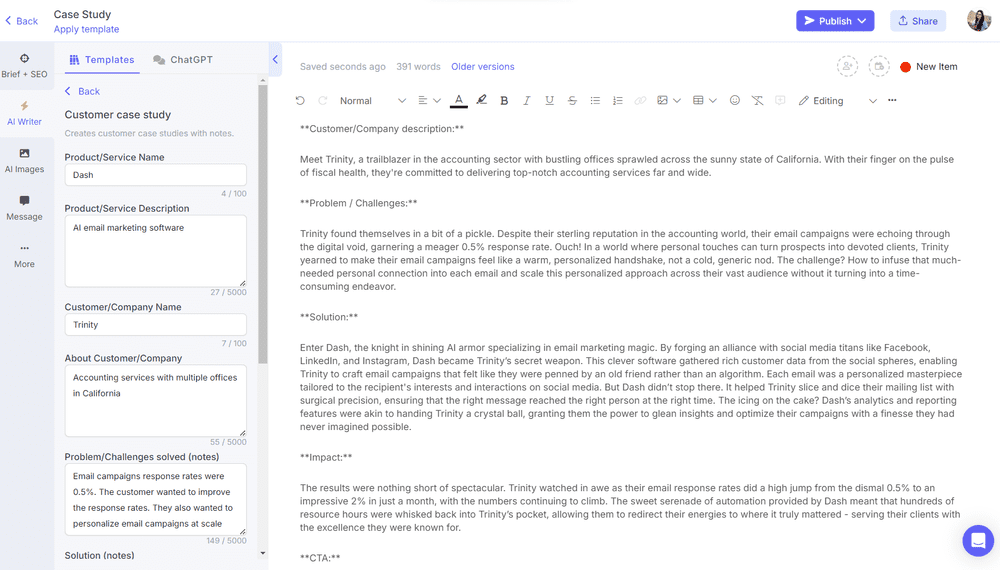
Besides, the AI case study generator, the platform provides 100+ different AI templates designed to assist you in creating blog posts, web content, landing pages, product descriptions, and much more. If you’re looking to enhance your content for SEO, the platform includes an AI keyword generator and an AI SEO brief generator. No matter what type of content you need to create, this platform likely has an AI template to suit your purpose. If you can’t find a template that fits your specific needs, you can easily make your own with custom AI templates.
Preparation steps for writing your case study
Before diving into the actual writing, there are a few preparatory steps that set the foundation for a solid case study.
- Identify the case: First things first, identify the specific case you will examine. Seek out a situation where your product or service has made a notable impact. This could be a longstanding client relationship or a new customer who achieved quick success. The focus should be on instances where tangible results are evident and impressive.
- Do your research: Arm yourself with as much data as possible. Interview stakeholders, dive into performance metrics, and perhaps even explore market research. To support these efforts, consider using reliable residential proxy servers to ensure secure and accurate data access. The more detailed your research, the more comprehensive your case study will be. Compile all your research into notes that you can provide the AI tool.
- Define the problem and your hypothesis: Once your research is in place, clearly define the core problem your customer faced. This should be specific and relatable, forming the hook of your case study. Pair this with a hypothesis regarding how your product or service addressed the issue, setting the stage for presenting your solution.
With these steps nailed down, you’re ready to create an engaging case study using your insights and AI’s abilities.

How to write a case study with AI
Using an AI case study generator can streamline this process of creating case studies, helping you write engaging stories without the usual time drain. Here’s a step-by-step guide on how to create an effective case study with AI assistance.
Step 1. Open the AI case study generator or create a custom AI template
Start by opening the AI content assistant or your content task page on Narrato. Search for the case study AI template. If this AI template doesn’t quite fit your requirements, you can create a custom AI template with your own prompts and inputs.
Step 2. Input basic details in the AI case study generator
After opening the tool, add these details.
- Product/service name: Paint a clear picture of the product/service. When your case study focuses on a product, make sure to mention any specific model, if relevant. This helps establish the context for your case study and provides readers with a clear understanding of what your product offers.
- Product/service description: Provide a short and informative overview of your product or service. Emphasize its main features and benefits, and explain how it addresses a specific problem for your customers.
- Company background: Briefly highlight why the company is a credible solution provider.
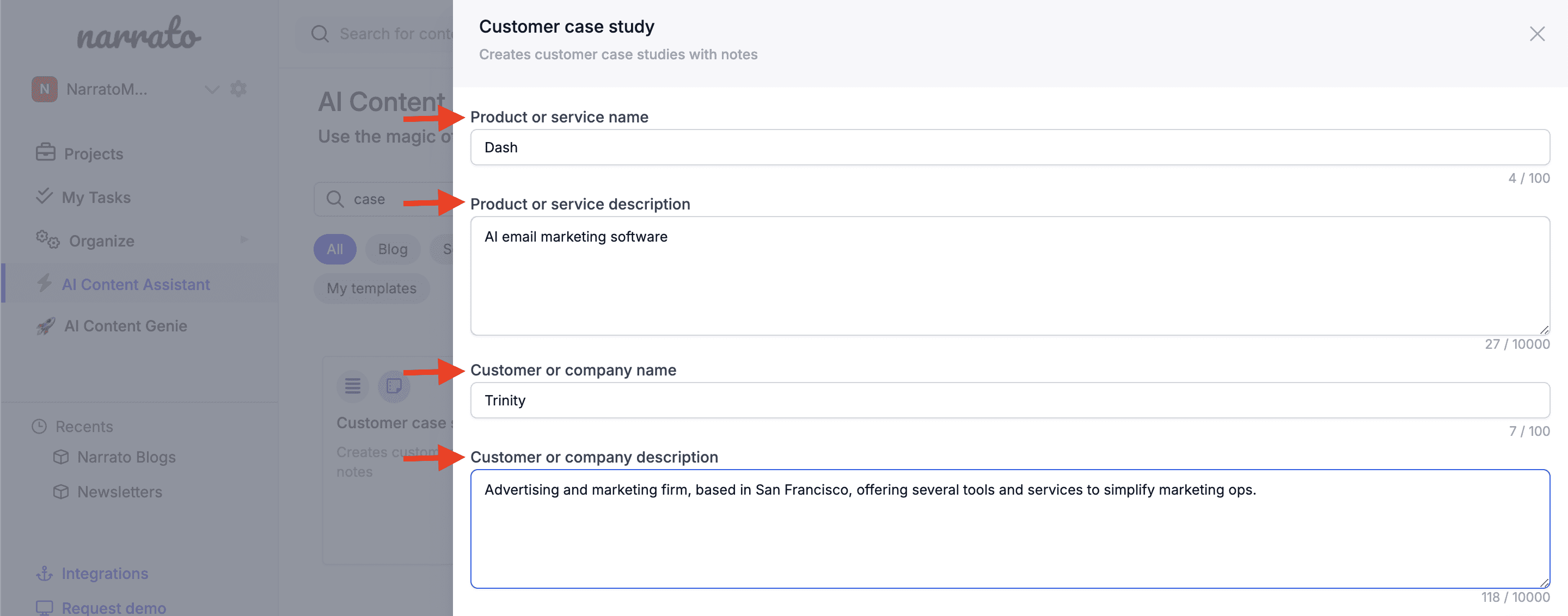
Step 3. Add your notes for more context
To enrich your case study, add notes that you compiled earlier to offer deeper insights into:
- Problems or challenges: The issues your customers were facing before turning to your product/service
- Solutions: How your product/service addresses these challenges
- Impact: Showcase the results, using both quantitative data (e.g., increased sales, reduced costs) and qualitative feedback (e.g., improved customer satisfaction).
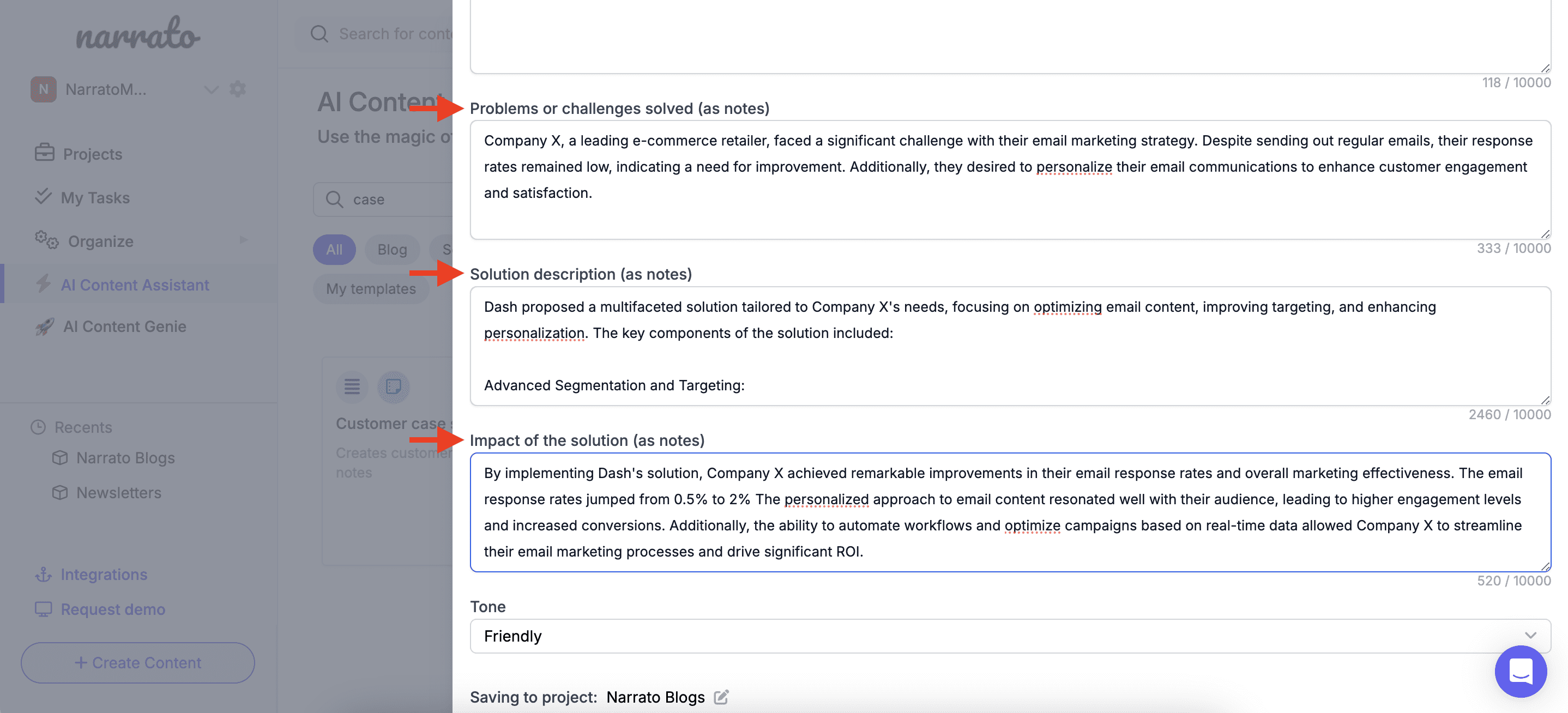
Step 4. Choose the desired tone for the case study
The tone of your case study affects how your audience engages with it. Consider what tone your target audience prefers and also the purpose of your case study. Would a formal tone better highlight your industry expertise, or would a casual tone create a more relatable narrative? You can also use Narrato’s AI brand voice generator to create a custom voice for your brand, which will help ensure your case study aligns perfectly with your brand identity.
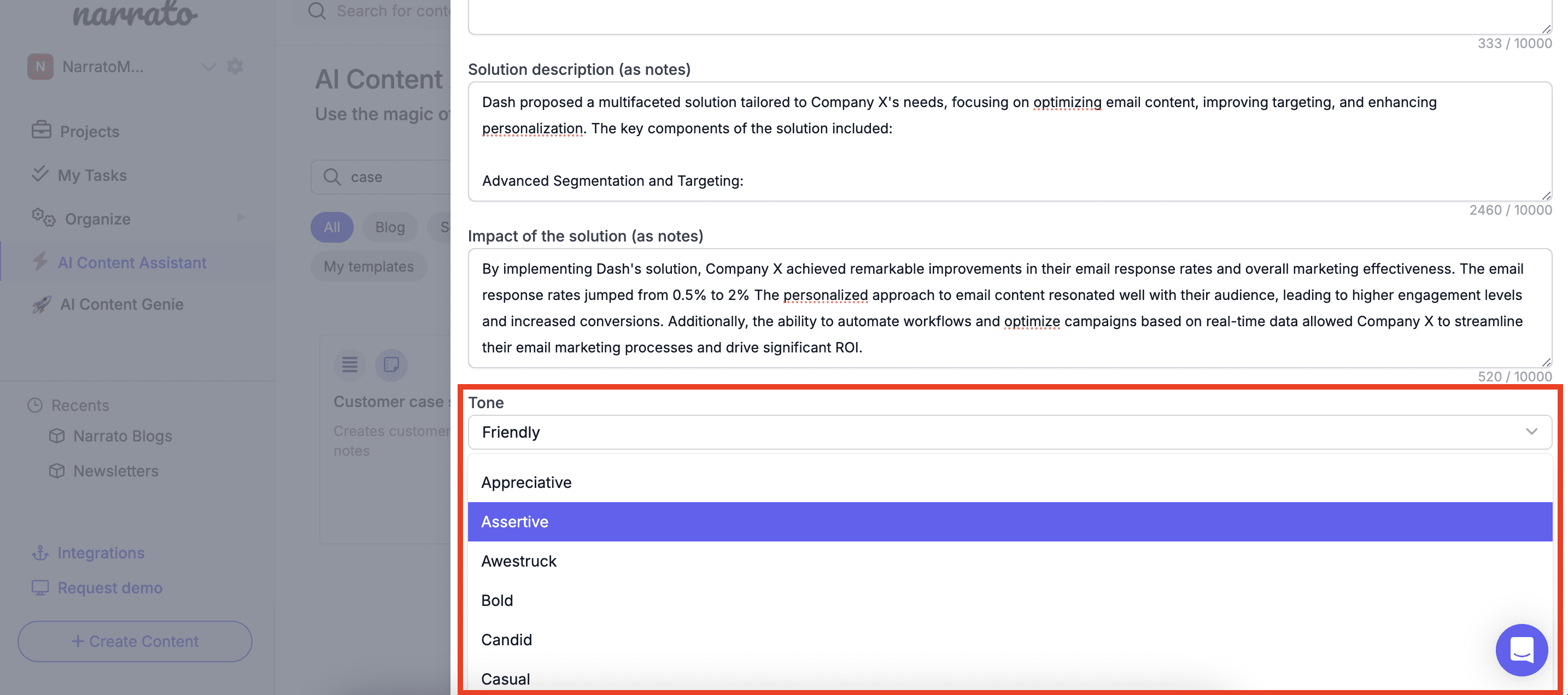
Once you’re done, click ‘Generate’ and will carefully analyze your inputs to create a comprehensive and detailed case study tailored to your needs.
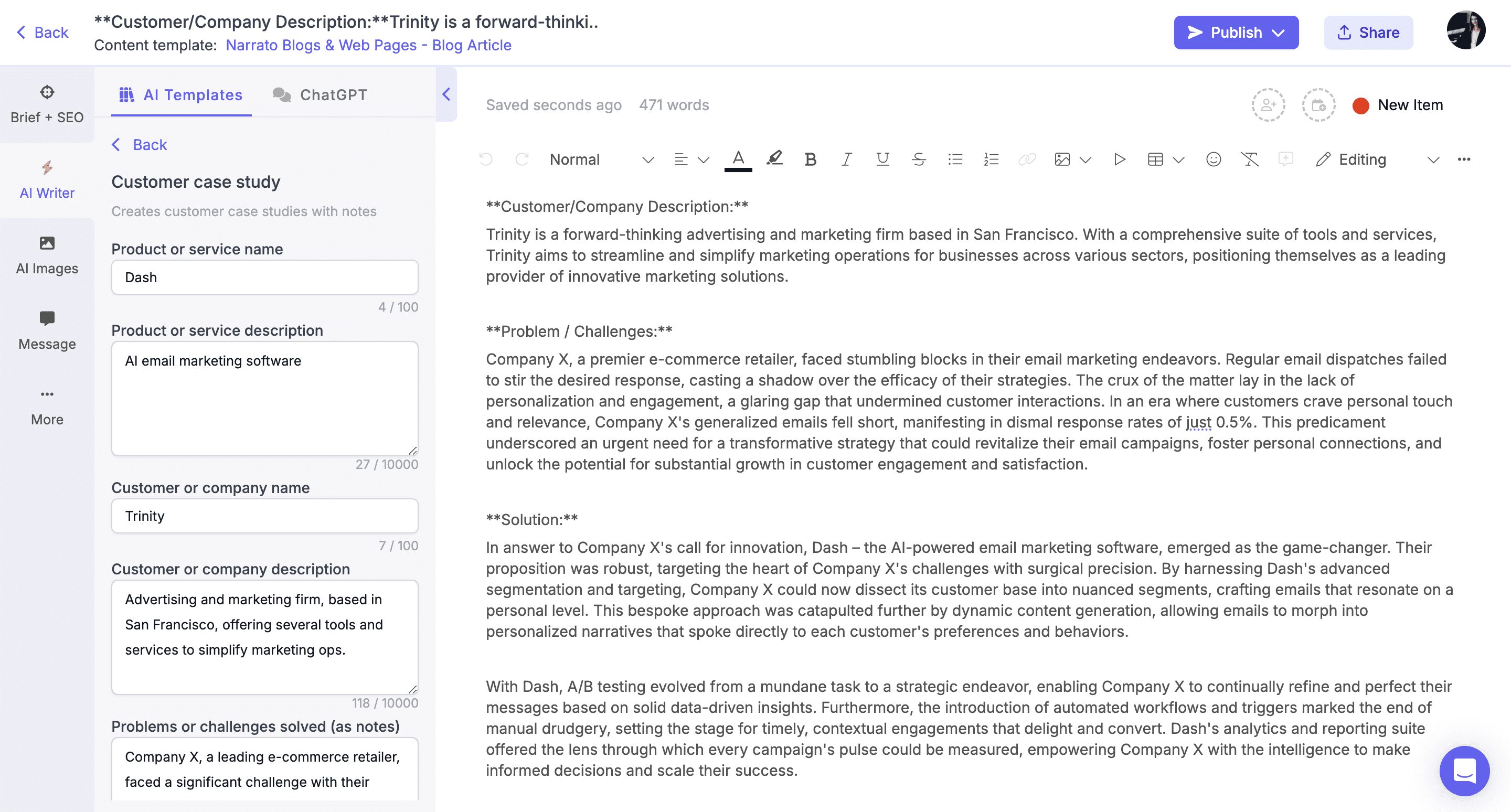
Step 5. Review and refine the case study
The AI will produce a great first draft for you, serving as a strong foundation. Now it’s your opportunity to bring your unique perspective and expertise into the mix. By adding your personal insights, you can enrich the content, ensuring it resonates with the intended audience. Take the time to refine and polish the draft, transforming it into a compelling and effective case study that clearly communicates your message and achieves your desired impact. Add layers of detail or clarify any ambiguous sections and ensure the narrative flows smoothly and addresses any potential questions from readers.
Tips for writing a compelling case study
1. Set a strong narrative with your case study intro
The introduction of your case study sets the stage for what’s to come. It’s your chance to grab the readers’ attention with an engaging opening that piques their curiosity. Consider starting with a compelling anecdote, an interesting fact, or a provocative question that draws readers in and makes them eager to learn more. As you continue, provide a glimpse into the main problem or challenge the case study addresses, giving readers a sense of what’s at stake. The introduction is where you establish the context and background necessary for understanding the issue, pulling readers into the journey and making them invested in the outcome.
2. Use storytelling techniques
Incorporate storytelling in your case study to make it more engaging and relatable for your audience. Start by describing the problem your client faced and the context behind it. Share their journey, highlighting the obstacles they overcame and the choices they made. Illustrate how your product or service led to positive change. Don’t forget to add anecdotes or testimonials to make the success story personal and inspiring. By telling a story, you can capture interest, create an emotional connection, and clearly show the value of your solution.
3. Support your hypothesis with real data and stats
When building your argument, it’s important to bolster your hypothesis with actual data and statistical evidence. This means gathering documented facts, figures, and measurable information from reliable sources to validate your claim. By including specific examples, numerical data, and relevant statistics, you can provide a solid foundation for your hypothesis, making it more credible and persuasive.
4. Make sure to add visuals and charts in your case study
Adding visuals and charts to your case study is important for several reasons. First, they help to break up large blocks of text, making the document more engaging and easier to read. Visuals such as images and diagrams can enhance understanding by illustrating key concepts or demonstrating processes that might be complex when explained solely through text. Charts, on the other hand, present data in an organized way, making it easier for readers to grasp trends, comparisons, and patterns at a glance. To create these visuals and charts, you can take the help of AI tools. Narrato’s AI image generator, for instance, can generate compelling visuals from simple text prompts. For charts and graphs, you can use a tool like Piktochart.
Wrapping up
That brings us to the end of our guide on how to write a case study. By automating the narrative creation processes, Narrato’s AI case study generator can save you a significant amount of time in case study creation, letting you focus on strategic creative tasks that truly need your attention. Just keep in mind that the human touch—through review and refinement—remains essential to ensure each case study resonates with your audience. So, give your marketing efforts a boost, and start generating case studies like a seasoned marketer today!


